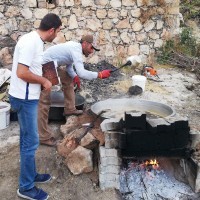Research Articles
Issue Reviewers











 Web
Web
Kyrgyz - Turkish Manas University, Faculty of Agriculture, Kyrgyz






Aim & Scope
International Journal of Life Sciences and Biotechnology (Int J. Life Sci. Biotechnol.) is an international peer-reviewed journal that publishes original articles from all biology and molecular biology studies, particularly in life sciences and biotechnology. The publication is in Turkish and English—also the main objective of Int J. Life Sci. Biotechnol. is to provide quality publications to scientists, researchers, and engineers from both academia and industry who want to communicate the latest developments and practices in their field.
Int J. Life Sci. Biotechnol. publishes original papers in various fields of Life Sciences and Biotechnology that cover, but are not limited to, the following areas:
- Agricultural Biotechnology
- Animal (livestock and fish production, physiology, breeding and genetics, biotechnology, etc),
- Animal Biotechnology
- Biochemical Genetics,
- Biochemistry
- Biodiversity and biodiscovery
- Bioinformatics and system biology
- Biology and Molecular Biology,
- Bioremediation and biodegradation
- Biotechnology
-Bioethics (Life Sciences and Biotechnology)
- Botany,
- Evolution and Population Genetics,
- Food Biotechnology
- Genetic engineering and cloning
- Lichens
- Genetics,
- Biotechnological product and Halal Food
- Industrial Biotechnology
- Medical Biotechnology
- Molecular Genetics
- Plant (Plant production, physiology, breeding and genetics, biotechnology, agronomy, horticulture, plant protection, etc.),
- Plant Biotechnology
- Soil (soil ecology, physics, chemistry, etc.)
-Polar Science (Life Sciences and Biotechnology)
Author Guidelines
GENERAL PRINCIPLES
1. The article should be submitted by the responsible author responsible as Microsoft Word (doc, docx).
2. The responsible author is responsible for monitoring all the processes of the article.
3. The main section headings should be bold and the first letter in capital letters, the first letter of the first word in the 2nd degree headings should be large. If possible, articles with the third degree titles should not be used in our journal.
4. The main headings and sub-headings should not be numbered.
5. Turkish and English titles of the articles should be short, descriptive and not more than fourteen words (except prepositions).
6. In the Pre-Control and Evaluation processes, the authors must submit the proposed corrections within 30 days at the latest. Otherwise the article will be rejected.
7. Please click here to see the article written according to the rules of our journal.
8. Except for the Turkish and English titles of the work, all remaining parts should be written on the right side.
9. The text should be written on an A4-size page, in 12-font size Times New Roman, and double-spaced.
10. There should be 3 cm margin on the left, right and top of the page.
11. Text should be written in a single column, all pages should be given a page number.
About the Ethics Committee
Are ethics committee permissions required for each article?
Ethics committee permissions are not requested for every article. It is requested for all articles in Turkish or foreign addresses that "require the permission of the ethics committee".
Research that requires the permission of the ethics committee;
• All kinds of research conducted using qualitative or quantitative approaches that require collecting data from participants using survey, interview, focus group study, observation, experiment, interview techniques,
• The use of humans and animals (including materials/data) for experimental or other scientific purposes,
• Clinical trials conducted on elderly people,
• Previous research on animals,
• Retrospective studies in accordance with the law on the protection of personal data.
Also;
• Stating that the ”Illuminated Consent Form" was taken in the case reports (case analysis),
• Obtaining permission from the owners for the use of scales, questionnaires, photos belonging to others and specifying,
• It should be stated that the copyright regulations are complied with for the intellectual and artistic works used.
• You can take advantage of the diagrams on the link at the point of whether the studies require the permission of the ethics committee.
Research that requires the Permission of the Ethics Committee.pdf (link will be added)
What permissions should be obtained other than Ethics Committee permissions?
• In case reports, information about the signing of the informed consent / consent form should be included in the article.
• It should be stated that the permission document was obtained from the institution where the research was conducted (Ministry of National Education, Ministries, etc.).
• It should be stated that permission has been obtained from the owners for the use of scales,
• questionnaires, photos belonging to others.
• ABSTRACT It should be stated that the copyright regulations are complied with for the ideas and works of art used.
Note: The information given in the section About Ethics Committee authorization was taken from the TRDizin web page. Attention is paid to this issue in our journal.]
About the Plagiarism Report
It is necessary to conduct a plagiarism scan for the article with the plagiarism program e in the Dergipark article upload section. There should be a maximum similarity rate of 15%, excluding the bibliography.
Note: Similarity reports are reviewed by editors. Not meeting every similarity requirement does not mean that the publication has committed plagiarism, and meeting every similarity requirement does not guarantee that plagiarism has not occurred. Plagiarism refers to unauthorized copying, while similarity may be mandatory in certain cases. For detailed information, you can obtain information from the links below.
- Scientific Research and Publication Ethics Directive
- Plagiarism” Based on Administrative Judgments
Files to be Uploaded during Article Submission
1- Article (Template) file (Scientific text of the article)
2- Author and Article information (Special information belonging to the Author and the Article)
3- Plagiarism Report (it will be made by "dergipark" in the article upload section)
4- Declaration of Ethical Responsibility and Copyright Agreement Form
5- Ethics committee permission (if ethics committee permission is required in your work)
Some Reminders
- It is not possible to submit articles to the journal without your membership in the journal. Click here to register.
- Make sure that you have sent all the requested information correctly before submitting your article.
- Don't forget to check your articles after the issue is published. After the article is published in the journal, an editing period of 5 days is given. When this period ends, the article is not edited. a correction article should be published in the next issue. In the case of our journal, this means that the correction will be published after six months. Therefore, please contact us as soon as possible for corrections that will not be subject to peer review after your articles are published.
The issues that are recommended to check after the article is published
-The title of the article in the first and second languages,
-Year, Volume, Number information, -Accuracy of charts and figures, -Possible layout errors,
-Spelling mistakes
-Erroneous statements, etc.
Note: The errors mentioned above should not be subject to the referee's opinion. In other words, requests for changes that involve altering the data in an article that has undergone referee review and has been accepted for publication in its current form should not be made and will not be taken into consideration.
Article withdrawal process in “dergipark”
The author has the right to withdraw the article while it is in new submission status. If the article is in lower roles or has at least 1 reviewer review, the author can request a withdraw with the approval of the editor. If the editor does not respond to the request within 15 days, the article will be automatically withdrawn.
During the production process, the author will only be able to send requests and the 15-day period will not apply. With this feature, a withdraw card has also been added to the editor panel. Withdraw requests can be viewed from this card.
click here for detailed information
NAMES SECTION
A double-blind peer reviewer system is applied in our journal. Therefore, the names and addresses of authors should not be given in the main text when loading the Manuscript to the system. Author names and contact information should be written on a separate cover page. The cover page is available in the article submission section of our journal.
ABSTRACT
The article can be written in Turkish and English. English and Turkish abstracts should be written at the beginning of the Turkish manuscripts.
The abstract should contain brief and clear information about the purpose, method and results of the article. 10 font size, single line spacing and maximum 250 words should be written. No reference should be made to the "Abstract".
Key words: Key words should be 10 font sizes, minimum 3 and maximum 5 words. Keywords must be separated with a comma (,) sign and should be in lowercase.
INTRODUCTION
The sections of the main part of the study should be written in 14 font sizes; Bold and the first letter should be capitalized; Article should have Introduction, Methods, Results, Discussion and Conclusion sections. The second level titles should be written in the left, in 12 font sizes, the first letter of the first word should be capitalized, bold and numbered. A line in the previous paragraph must be separated by a space.
FIGURES AND TABLES
In the Turkish article for Figures and Tables;” Şekil“, ”Tablo“; whereas in English article “Fig”, “Table” should be used (Table 1, Fig 1).
Figure and Table words should be written in bold, and at the end of the description of figures and tables should not have a dot (.)
Figures, graphics, photographs and the like should be written under Figures and written with 11 fonts. Figure and Table should be given in the main document in the relevant places, should not be uploaded as separate files or should not be added to the end of the text.
Examples
Table 1 Possible effects of genetically modified organisms
Table 2 Methods of tissue culture in tomato plants
Fig 1 Amount of GMO production in the world
Fig 2 Countries with the highest number of GM cultivation in the world
CITATION INSIDE THE TEXT
In the text, the author should be numbered. Name and year should not be specified.
Example: Potatoes produced on a global scale are used in many basic areas [1, 2, 3]. Fifty percent of primarily produced potatoes are used for fresh consumption, such as baking, frying, boiling [4, 5, 6, 7].
REFERENCES
The references section should be written in 10 font sizes and without hanging indentations. In the references section, italics should not be written except in italic words such as “in vivo, in vitro, ex-situ” and species names. References should be written according to “Chicago style”. Besides, there is an endnote style preparing for "International Journal of Life Sciences and Biotechnology". You can prepare your references using that style. For Endnote style, you can reach it by clicking on the endnote at the bottom right part of the main page of the journal.
Example of an article with one author;
Marakli, S., A Brief Review of Molecular Markers to Analyze Medicinally Important Plants. International Journal of Life Sciences and Biotechnology, 2018. 1 (1): p. 29-36. Doi:xxxxxxxxxxxxxxxxxxxxxxxxx
Example of an article with two authors;
Kocacaliskan, I. and I. Tailor, Allelopathic effects of walnut leaf extracts and juglone on seed germination and seedling growth. The Journal of Horticultural Science and Biotechnology, 2001. 76 (4): p. 436-440. Doi:xxxxxxxxxxxxxxxxxxxxxxxxx
Example of an article with three authors;
Aksoy, H.M., Y. Kaya, and T.H. Tengku Abdul Hamid, Expression of the dspA/E gene of Erwinia amylovora in non-host plant Arabidopsis thaliana. Biotechnology & Biotechnological Equipment, 2017. 31(1): p. 85-90.Doi:xxxxxxxxxxxxxxxxxxxxxxxxx
Examples of articles with four or more authors;
Kaya, Y., et al., Evaluation of transgenic Nicotiana tabacum with dehE gene using transposon based IRAP markers. American Journal of Plant Sciences, 2013. 4(08): p. 41. Doi:xxxxxxxxxxxxxxxxxxxxxxxxx
Example for the book;
Kocalishkan, I., Allelopathy. 2006, Ankara, Turkey: Our Office Press-In Turkish. ISBN:xxxxxxxxxxxxxx
Example for Book Chapter;
Kaya, Y., F.Z. Huyop, and M.F. Edbeib, Genetic Diversity in Plants, Advances in Biosciences, F.Z. Huyop and S. Mohammed, Editors. 2019, Penerbit UTM Press. Malaysia: Malaysia. p. 04-24. Doi:xxxxxxxxxxxxxxxxxxxxxxxxx or ISBN:xxxxxxxxxxx
Thesis
Kaya, Y., Regeneratıon of Dalapon Tolerant Nicotıana Tabacum By Expressıng Dehalogenase E Gene Through Agrobacterıum Tumefaciens – Medıated Transformatıon. 2013, Universiti Teknologi Malaysia: Malaysia.
Example for congress/conferences paper;
Arvas, Y.E., et al., Possible Effects of Genetically Modified Plants on Biodiversity, in I. International Organic Agriculture and Biodiversity Symposium. 2017: Berlin- Germany. p. 65.
Ethical Principles and Publication Policy
Ethical standards for publication exist to ensure high-quality scientific publications, public trust in scientific findings, and that people receive credit for their ideas. In addition, the authors are encouraged to follow the ethical guidelines of the Committee on Publication Ethics (COPE), which can be viewed on the COPE website.
International Journal of Life Sciences and Biotechnology (Int J. Life Sci. Biotechnol.) is an electronic peer-reviewed international journal trying to have the highest standards of publication ethics. For that, we affirm the principles of the Publication Ethics and Malpractice Statement.
If malpractice is discovered at any time, even after the publication, the articles not by these standards will be removed from the publication. Int J. Life Sci. Biotechnol. is checking all papers in a double-masked peer-review process. We also check for plagiarism, research fabrication, falsification, and improper use of any organisms in research. We will also report any cases of suspected plagiarism or duplicate publishing. Int J. Life Sci. Biotechnol. reserves the right to use plagiarism-detecting software to screen submitted papers at all times.
All the Int J. Life Sci. Biotechnol.Editorial Team members;
Respect their journal's constituents (readers, authors, reviewers, and the human subjects of research) by:
1. Making the journal's processes (e.g., governance, editorial staff members, number of reviewers, review times, acceptance rate) transparent;
2. Thanking reviewers for their work; Protecting the confidentiality of human subjects.
3. Promote self-correction in science and participate in efforts to improve the practice of scientific investigation by: Publishing corrections, retractions, and critiques of published articles; Take responsibility for improving scientific investigation and writing in the larger community of potential authors and readers.
4. Assure honesty and integrity of the content of their journal and minimize bias by: Managing conflicts of interest; Maintaining confidentiality of information;
Separating the editorial and business functions of the journal.
5. Improve the quality of their journal by: Becoming familiar with the best practices in editing, peer review, research ethics, methods of investigation, and the rationale and evidence base supporting them; Establishing appropriate programs to monitor journals' performance; Soliciting external evaluations of the journal's effectiveness
Authors and Authors' responsibilities;
Authorship is a way of making explicit both credit and responsibility for the contents of published articles. Credit and responsibility are inseparable. The guiding principle for authorship decisions is to present an honest account of what took place. Criteria for authorship apply to all intellectual products, including electronic publications of words, data, and images. The Int J. Life Sci. Biotechnol. Editorial should make their policies on authorship transparent and accessible.
- Everyone who has made substantial intellectual contributions to the study on which the article is based (for example, to the research question, design, analysis, interpretation, and written description) should be an author.
- It is dishonest to omit mention of someone who has participated in writing the manuscript ("ghost authorship") and unfair to omit investigators who have had a critical engagement with other aspects of the work.
- Only an individual who has made substantial intellectual contributions should be an author.
- Performing technical services, translating text, supplying materials, and providing funding or administrative oversight over facilities where the work was done is insufficient for authorship. However, these contributions may be acknowledged in the manuscript.
- It is dishonest to include authors only because of their reputation, position of authority, or friendship ("guest authorship").
- One author (a "guarantor") should take responsibility for the integrity of the work as a whole. Often, this is the corresponding author who sends in the manuscript and receives reviews, but other authors can also have this role. All authors should approve the final version of the manuscript.
- It is preferable that all authors be familiar with all aspects of the work. However, modern research is often done in teams with complementary expertise, so every author may not be equally familiar with all aspects of the work. For example, a biostatistician may have greater mastery of statistical aspects of the manuscript than other authors but have somewhat less understanding of clinical variables or laboratory measurements. Therefore, some authors' contributions may be limited to specific aspects of the work.
- All authors should comply with the journals' policies on conflict of interest.
- Editors should not arbitrarily limit the number of authors.
- There are legitimate reasons for multiple authors in some research, such as multi-center, randomized controlled trials. In these situations, a subset of authors may be listed with the title, with the notation that they have prepared the manuscript on behalf of all contributors, who are then listed in an appendix to the published article.
- A "corporate" author (e.g., a "Group" name) representing all authors in a named study may be listed as long as one investigator takes responsibility for the work as a whole. In either case, all individuals listed as authors should meet the criteria for authorship whether or not they are listed explicitly on the byline.
- If editors believe the number of authors is enormous relative to the scope and complexity of the work, they can ask for a detailed description of each author's contributions. If some do not meet the criteria for authorship, editors can require that their names be removed as a condition of publication.
- The authors should decide the order in which authors are listed in an article.
- No one other than the authors knows as well as they do their respective contributions and the agreements they have made among themselves.
- Many different criteria are used to decide the order of authorship. Among these are relative contributions to the work and situations where all authors have contributed equally, alphabetically, or randomly.
- Readers cannot know, and should not assume, the meaning of the order of authorship unless the authors describe the authors who may want to include with their manuscript a description of how the order was decided. If so, editors should welcome this information and publish it with the manuscript.
- Authorship disputes are best settled locally before journals review the manuscript. However, editors may become involved in resolving authorship disputes at their discretion.
- Changes in authorship at any stage of manuscript review, revision, or acceptance should be accompanied by a written request and explanation from all of the original authors.
- The integrity of the published record of scientific research depends not only on the validity of the science but also on honesty in authorship.
- Editors and readers need to be confident that authors have undertaken the work described and have ensured that the manuscript accurately reflects their work, irrespective of whether they took the lead in writing or sought assistance from a writer in the field.
- The scientific record is distorted if the primary purpose of an article is to persuade readers in favor of a particular interest rather than to inform and educate, and this purpose is concealed.
- Ghost authorship exists when someone has made substantial contributions to writing a manuscript; this role is not mentioned in the manuscript itself. To prevent some instances of ghost authorship, editors should make clear in their journal's information for authors that writers can be legitimate contributors and that their roles and affiliations should be described in the manuscript. When editors detect ghostwritten manuscripts, their actions should involve both the submitting authors and commercial participants if they are involved. Several actions are possible:
publish a notice that a manuscript has been ghostwritten, along with the names of the responsible companies and the submitting author; alert the authors' academic institutions identify the commercial companies, and provide specific names if contacted by the popular media or government organizations; These actions would increase transparency and public accountability about ghostwriting, manipulate the scientific record, and deter others from this practice.
Peer-review process
Duties of Reviewers
Contribution to Editorial Decisions
- Peer review assists the Editor in making editorial decisions and, through the editorial communications with the author, may also assist the author in improving the paper.
Promptness
- Any selected referee who feels unqualified to review the research reported in a manuscript or knows its prompt review will be impossible should notify the Editor and excuse himself from the review process.
Confidentiality
- Any manuscripts received for review must be treated as confidential documents. They must not be shown to or discussed with others except as authorized by the Editor.
Standards of Objectivity
- Reviews should be conducted objectively. Personal criticism of the author is inappropriate. Referees should express their views clearly with supporting arguments.
Acknowledgment of Sources
- Reviewers should identify relevant published work that the authors have not cited. Any statement that an observation, derivation, or argument had been previously reported should be accompanied by the relevant citation. A reviewer should also call to the Editor's attention any substantial similarity or overlap between the manuscript under consideration and any other published paper they have personal knowledge.
Disclosure and Conflict of Interest
- Privileged information or ideas obtained through peer review must be kept confidential and not used for personal advantage. Reviewers should not consider manuscripts with conflicts of interest resulting from competitive, collaborative, or other relationships or connections with any authors, companies, or institutions connected to the papers.
Publication Ethics
Ethical standards for publication exist to ensure the quality of scientific publications. International Journal of Life Sciences and Biotechnology, published by the International Society of Academicians, is committed to publishing only original manuscripts and work that has neither been published elsewhere (nor is under review elsewhere). So, avoiding specific ethical violations (like plagiarism, simultaneous submission, data fabrication, duplicate publication, improper author contribution, and citation manipulation) is critical.
Plagiarism: Plagiarism is deliberately using someone else's ideas or other original material without acknowledging or referring to its source. Copying even a tiny part ( for example, one sentence) from someone else's manuscript, or even one of your own that has previously been published, without proper citation, is considered plagiarism.
Simultaneous Submission: Simultaneous submission occurs when a manuscript is submitted to a journal after another journal has already considered it.
Data Fabrication and Falsification: Data fabrication and falsification means the researcher did not do the study but made up the results and recorded or reported the fabricated information. Data falsification means the researcher did the experiment but manipulated, changed, or omitted data or results from the research findings. This would lead to public distrust and less willingness to provide funding support.
Duplicate Publication: Duplicate publication occurs when two or more papers, without full cross-referencing, share the same hypotheses, data, and conclusions.
Improper Author Contribution: All listed authors must have made a significant contribution to the research in the paper.
Citation Manipulation: Citation Manipulation includes excessive citations in the submitted manuscript that do not contribute to the article's content and have been included solely to increase citations to a given author's work or to articles published in a particular journal.
Process for identification of and dealing with allegations of research misconduct: Editors of the International Journal of Life Sciences and Biotechnology are reasonable to identify and prevent the publication of papers where research misconduct has occurred, including plagiarism, citation manipulation, and data falsification/fabrication, among others. In doing so, the International Journal of Life Sciences and Biotechnology follows COPE's guidelines in dealing with allegations.
Copyright and Access
International Journal of Life Sciences and Biotechnologyadheres to the Budapest Open Access Initiative and defines its Open Access policy according to the definition developed in the original BOAI:
By "open access" to [peer-reviewed research literature], we mean its free availability on the public internet, permitting any users to read, download, copy, distribute, print, search, or link to the full texts of these articles, crawl them for indexing, pass them as data to software, or use them for any other lawful purpose, without financial, legal, or technical barriers other than those inseparable from gaining access to the internet itself. The only constraint on reproduction and distribution, and the only role for copyright in this domain, should be to give authors control over the integrity of their work and the right to be appropriately acknowledged and cited. [See, http://www.budapestopenaccessinitiative.org/boai-10-recommendations]
Int J. Life Sci. Biotechnol. views open access to academic publications and research as an immutable part of academic endeavor. The publisher recognizes the essence of public good provided by the journal and hence accepts its responsibility as a public service to academic and intellectual betterment.
The publisher is committed to open access to all academic endeavors and accepts its duty to make published content permanently available and freely accessible to all sections of the worldwide academic community. The publisher does not charge any financial fees for the processing, submitting, and publishing of manuscripts. The publisher perpetually commits to free and universal access to its published content.
The publisher, via its host-providing institution Dergipark, uses Lockss to archive and preserve its online content.
Authors retain their intellectual property: All articles published on "Int J. Life Sci. Biotechnol. has a Creative Commons Attribution 4.0 license, and the journal does not require a copyright transfer.
Copyright
In addition to being available on ISM, authors are encouraged to post any version of their manuscript in their institutional repositories or on their websites at any stage of the pre-and post-publication process. As an open-access journal, we do not require authors to transfer copyright to Int J. Life Sci—Biotechnol. to publish in the journal. Authors retain complete control of their intellectual property, and we use the Creative Commons Attribution 4.0 license for all works published in the journal. This means anyone can share this material in any medium or format and remix, transform, and build upon the content as long as they provide attribution to the creator.
Archiving and Publishing Schedule
International Journal of Life Sciences and Biotechnology has been published four times yearly since 2018. All the content from the beginning to the end will be available forever on the International Journal of Life Sciences and Biotechnology's website. Also, the International Journal of Life Sciences and Biotechnology is included in CAS databases, CrossRef, Google Scholar, and Asos İndex.
Ownership and management
The International Society of Academicians has tried to make a practical division between the policy-makers of services/research and the scientific decision-makers of scholarly materials in Int J. Life Sci. Biotechnol. opinion, this is an essential issue that the Int J. Life Sci should not neglect. Biotechnol. Management systems because it can lead to low-quality outputs and deviate from the way of science.
The International Society of Academicians has three significant principles in scholarly publishing:
- The independence of Editorial Board members, especially the Editor-in-Chief, in making scientific decisions;
- Performing appropriate peer-review model for selecting scholarly materials; and
- The structural consistency of published materials helps the readers and researchers to recover and use them efficiently;
International Society of Academicians has tried to resist all parameters that conflict with these principles and also make all the participants of scholarly material production aware of the consequences of deviation from these principles.
The following are guidelines for protecting the responsibility and authority of the Editor (s)-in-chief and owners:
- The conditions of the editor-in-chief's employment, including authority, responsibilities, term of appointment, and mechanisms for resolving conflict, should be explicitly stated and approved by both the Editor and owners before the Editor is appointed.
- Editors-in-chief should have full authority over the journal's editorial content, generally referred to as "editorial independence." Owners should not interfere in evaluating, selecting, or editing individual articles, either directly or by creating an environment in which editorial decisions are strongly influenced.
- Editorial decisions should be based mainly on the validity of the work and its importance to readers, not the commercial success of the journal. Editors should be free to express critical but responsible views about all aspects of life sciences and biotechnology without fear of retribution, even if these views might conflict with the commercial goals of the publisher. To maintain this position, editors should seek input from various advisors, such as reviewers, editorial staff, an editorial board, and readers.
- Editors-in-chief should establish procedures that guard against the influence of commercial and personal self-interest on editorial decisions.
- Owners have the right to hire and fire editors-in-chief. Still, they should dismiss them only for substantial reasons, such as a pattern of irresponsible editorial decisions, scientific misconduct, disagreement with the long-term editorial direction of the journal, or personal behavior (such as criminal acts) incompatible with a position of trust. Furthermore, any evaluation on which hiring or firing is based should be performed by a panel of independent experts rather than a small number of executives of the owning organization.
- Editors-in-chief should report to the highest governing body of the owning organization, not its administrative officers. This body should make significant decisions regarding the Editor's employment with open discussion and time to hear from all interested parties. Some owners have found it helpful to appoint an independent board to advise them on major decisions regarding their Editor and journal.
- Editors should resist any actions that might compromise these principles in their journals, even if it places their position at stake. If significant transgressions occur, editors should participate in drawing them to the attention of the international scientific community.
Revenue sources/Advertising/Direct marketing
The International Journal of Life Sciences and Biotechnology is financially supported entirely by the International Society of Academicians and has no other sources for earning funds. International Journal of Life Sciences and Biotechnology accepts No advertisements on the site or as a report article.
Web site
The International Journal of Life Sciences and Biotechnology's Web site, including its text, shall demonstrate that care has been taken to ensure high ethical and professional standards.
Redundant Publications
Redundant publications involve the inappropriate division of study outcomes into several articles.
Sanctions
Suppose there are documented violations of any of the policies mentioned above in any journal, regardless of whether or not the violations occurred in a journal published by IJLSB. In that case, the following sanctions will be applied:
Immediate rejection of the infringing manuscript.
Immediate rejection of every other manuscript submitted to any journal published by IJLSB by any of the authors of the infringing manuscript.
There is a prohibition against all of the authors for any new submissions to any journal published by IJLSB, either individually or in combination with other authors of the infringing manuscript, as well as in combination with any other authors. This prohibition will be imposed for a minimum of 36 months.
In cases where the violations of the above policies are found to be particularly egregious, the publisher reserves the right to impose additional sanctions beyond those described above.
Price Policy
“International Journal of Life Sciences and Biotechnology” is an Open Access Journal and does not charge any printing charges from authors, during article delivery, assessment and printing stages.
